Proper goalie glove sizing is crucial for performance and control. Gloves should fit snugly, allowing precise ball handling without restricting movement. Different brands and cuts offer varying fits, so measuring hand length and palm circumference is essential. Youth and adult sizing differ, and removable fingers can affect fit. Always refer to brand-specific size charts for accuracy.
Understanding the Importance of Proper Fit
A proper fit is essential for goalkeeper gloves to ensure optimal performance and control. Gloves that are too tight can restrict movement and cause discomfort, while gloves that are too loose may compromise grip and precision. A snug fit allows goalies to handle the ball effectively, making it easier to catch, throw, and deflect shots. Proper fit also reduces the risk of injury by providing adequate support and protection for the hands. Goalkeepers who wear gloves that are too large may struggle with controlling the ball, especially when throwing or handling high-speed shots. Conversely, gloves that are too small can limit finger movement and dexterity. Achieving the right balance ensures peak performance, confidence, and durability of the gloves. Proper fit is a critical factor in a goalkeeper’s ability to perform at their best.
Overview of Goalie Glove Size Charts
Goalie glove size charts are essential tools for determining the right fit. These charts typically provide measurements based on hand length and palm circumference, helping goalies match their hand size to the appropriate glove size. Most charts include a range of sizes, from youth to adult, and often cater to different hand shapes and preferences. They may list measurements in inches or centimeters, offering a clear guide for selection. Some charts also account for variations in glove cuts, ensuring compatibility with specific styles. By referencing a size chart, goalies can avoid the guesswork of choosing the correct size. Consistency across brands is not guaranteed, so comparing measurements within a chart is crucial. A well-structured size chart ensures that goalies can find gloves that offer the perfect balance of comfort, control, and performance. This resource is invaluable for both novice and experienced players seeking optimal fit and functionality.
Key Factors in Determining Glove Size
Key factors include hand length, palm circumference, and shape to ensure a proper fit. Proper fit is crucial for performance, so measuring these aspects correctly ensures the glove isn’t too tight or too loose.
Measuring Hand Length for Goalie Gloves
Measuring hand length for goalie gloves involves determining the distance from the tip of the middle finger to the base of the palm. This measurement is crucial for ensuring a proper fit, as it directly impacts both comfort and performance. A flexible tape measure or a string and ruler can be used for accuracy. It’s important to measure the dominant hand, as this will be the primary hand used for catching and throwing. Consistency is key, so taking multiple measurements can help ensure reliability. Additionally, considering variations between brands and styles is essential, as different manufacturers may have slightly different sizing guidelines. Precise measurement leads to the best fit, balancing snugness for control and space for comfort during extended use.
Measuring Palm Circumference
Measuring palm circumference is a critical step in determining the correct size for goalie gloves. This measurement focuses on the width of the hand, specifically around the palm. To measure accurately, wrap a flexible tape measure or a string around the widest part of the palm, just below the knuckles. Ensure the hand is relaxed, with fingers closed gently. This measurement helps determine how the glove will fit when the hand is in a natural catching position. Proper palm circumference ensures the glove isn’t too tight, restricting movement, or too loose, affecting control. Goalies with broader palms may require larger sizes, while narrower palms may fit better in smaller gloves. Accurate measurement ensures optimal performance, as it directly impacts grip, comfort, and the ability to handle the stick effectively during gameplay.
How to Use a Goalie Glove Size Chart
Using a goalie glove size chart is a straightforward process that ensures a proper fit. Start by locating the chart provided by the manufacturer or retailer, as sizing can vary between brands. Match your hand length and palm circumference measurements to the corresponding sizes on the chart. Most charts list measurements in inches or centimeters, making it easy to find your size. Pay attention to whether the chart is for youth or adult gloves, as sizing differs significantly. Once you’ve identified your size, consider factors like grip preference and fit type (snug or loose). Some charts also provide guidance for different hand shapes or playing styles. If unsure, compare your measurements to multiple charts or consult customer reviews for insights. Accurate use of a size chart ensures a glove that balances comfort and performance, crucial for goalies to maintain control and agility during games.
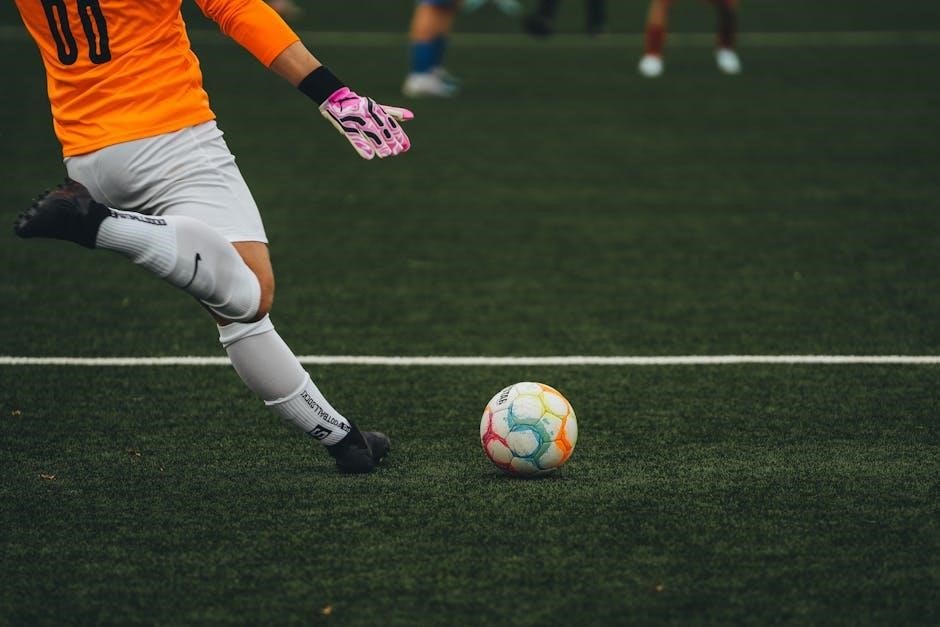
Understanding Glove Fit and Sizing
Proper glove fit is crucial for goalie performance, ensuring control, protection, and maneuverability. A well-fitting glove prevents restrictive movement while maintaining precision. Ill-fitting gloves can hinder performance and cause discomfort.
The Difference Between Snug and Loose Fits
A snug fit provides a glove that closely follows the shape of your hand, offering precise control and better feel for the puck. It minimizes excess material, reducing bulk and allowing quicker reflexes. A loose fit, while offering more comfort, can lead to reduced precision and slower reactions. Goalies often prefer a snug fit for better performance, but personal preference plays a role; However, a glove that is too tight can restrict movement and cause discomfort. A loose fit may be preferred by those prioritizing comfort over maximum control. Proper fit is about balancing tightness and freedom of movement. Snug gloves enhance stickhandling, while loose gloves may compromise accuracy. Goalies must weigh these factors based on their style and priorities. A well-fitting glove is neither overly restrictive nor excessively roomy, ensuring optimal performance and protection.
Why Proper Fit Matters for Performance
A proper fit in goalie gloves is crucial for optimal performance on the ice. A well-fitting glove ensures precise control over the stick, allowing for accurate stickhandling and puck placement. It also enhances grip and feel, which are essential for making quick reactions and confident saves. A glove that fits correctly minimizes distractions, enabling goalies to focus on the game without discomfort or restriction. Poorly fitting gloves can lead to reduced dexterity, affecting a goalie’s ability to perform critical skills like poke checks and glove saves. Additionally, a proper fit ensures better protection, as the padding stays in place during impacts, safeguarding the hand from injury. A glove that is too tight or too loose can compromise both performance and protection, making it harder to maintain peak effectiveness in the net. Proper fit directly impacts a goalie’s ability to execute skills and protect themselves during the game.
How Glove Cut Affects Size and Fit
The cut of a goalie glove significantly influences its size and fit. Different cuts, such as traditional, anatomical, or hybrid designs, alter how the glove conforms to the hand. A traditional cut typically offers a more relaxed fit, while an anatomical cut is tighter and contours to the natural shape of the hand. The cut also affects the placement of padding, fingers, and the thumb, which can make the glove feel larger or smaller than its actual size. For example, a glove with a more streamlined cut may feel snug even if the measured size is correct. Conversely, a bulkier cut might provide a looser fit. Understanding the cut is essential for ensuring the glove matches the goalie’s hand shape and preferences. The right cut enhances comfort, control, and performance, making it a critical factor in choosing the perfect glove.
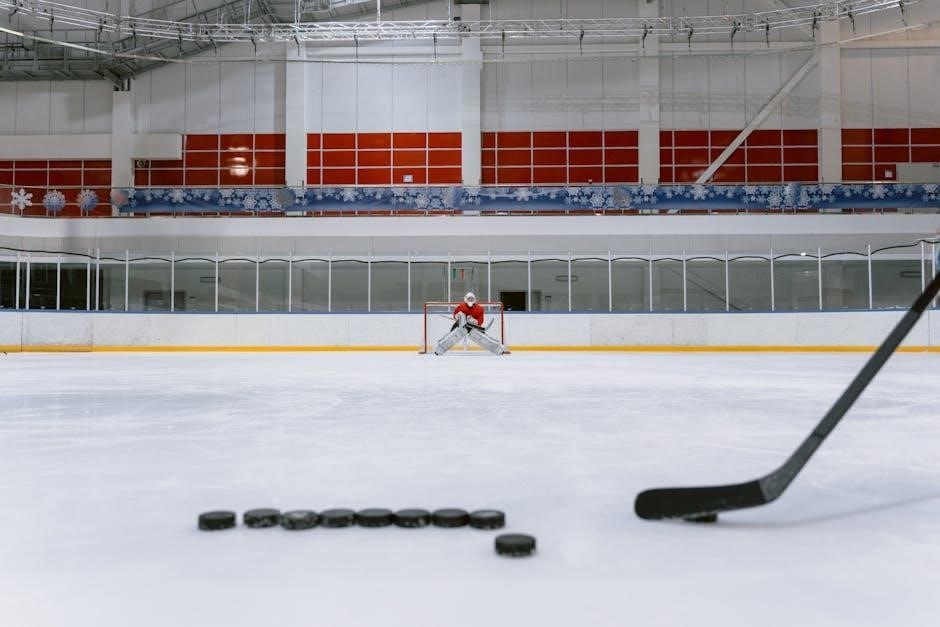
Special Considerations for Goalie Gloves

Special considerations include factors like removable fingers, youth sizing, and material flexibility. These elements can alter fit and sizing, requiring careful evaluation to ensure optimal comfort and performance for goalies.
Youth vs. Adult Sizing Differences
Youth goalie gloves are designed for smaller hands and feature shorter fingers and narrower palms compared to adult sizes. They often include adjustable straps and flexible materials to accommodate growing hands and provide a snug fit. Adult gloves, however, are larger and more robust, with thicker padding and reinforced palms for better protection in high-level play. Brands typically offer distinct sizing charts for youth and adult gloves, reflecting these physical differences. Youth gloves prioritize comfort and mobility, while adult gloves focus on durability and performance. Proper sizing for young goalies is crucial to ensure they can handle the glove effectively without sacrificing movement. Adults, on the other hand, may prefer a tighter fit for better control. Both groups benefit from trying gloves on to confirm the best fit, as sizing can vary between brands and models.
Impact of Removable Fingers on Sizing

Removable fingers in goalie gloves offer customization but can influence sizing accuracy. These fingers, often found in higher-end models, allow goalies to tailor their glove to personal preferences. However, their presence can alter the overall fit, as they add bulk and weight. When sizing, it’s important to consider whether the fingers are removable, as this may affect how snug or loose the glove feels. Some goalies prefer a tighter fit with removable fingers, while others opt for a bit more room. Size charts may vary for gloves with this feature, so consulting brand-specific guides is essential. The flexibility and dexterity provided by removable fingers can enhance performance but require careful sizing to avoid compromising grip or protection. Proper fit ensures optimal functionality, making it crucial to test gloves with removable fingers before purchase.

How Grip and Palm Material Affect Fit
The grip and palm material of goalie gloves significantly influence their fit and performance. Thicker, more durable materials often provide a snugger fit, while thinner materials may feel looser. High-quality palms with superior grip can reduce hand movement, offering better control; Conversely, softer materials might stretch over time, altering the glove’s original fit. The density of the palm padding also plays a role; denser foam provides more protection but can feel stiffer, potentially affecting dexterity. When choosing a glove, it’s essential to consider how the material interacts with your hand shape and preferences. Some goalies prefer a firmer, more responsive feel, while others prioritize flexibility. Brand-specific materials vary, so consulting size guides and trying gloves on can help ensure the best fit. Proper grip and palm material ensure both comfort and functionality, making them critical factors in sizing decisions.
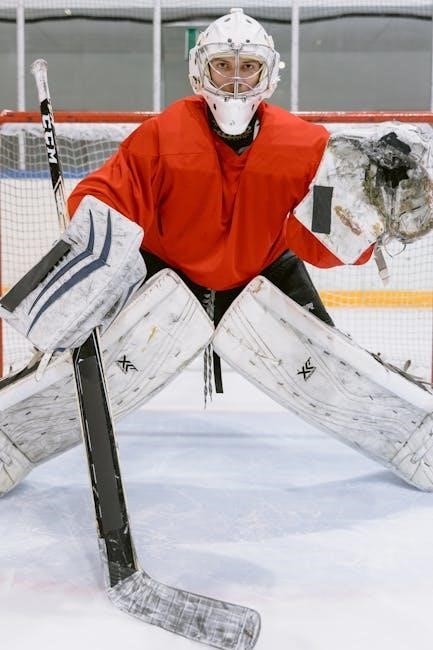
Brand-Specific Sizing Variations
Goalie glove sizing varies between brands due to differences in design, materials, and fit preferences. Some brands offer a snug fit, while others provide a more relaxed feel. Always compare sizing charts across brands to ensure the best fit for your hand shape and style.
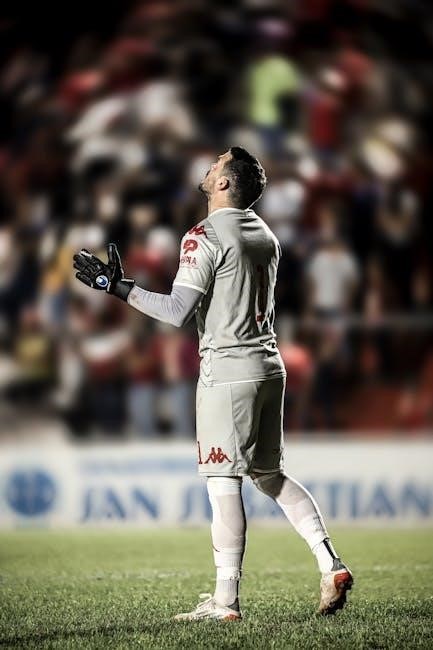
Common Differences Between Brands
Goalie glove brands often have distinct sizing approaches, making direct comparisons challenging. For instance, some brands like Warrior and True Hockey prioritize a snug, responsive fit, catering to goalies who prefer maximum control. In contrast, brands like CCM and Bauer may offer a slightly roomier fit, appealing to those who value comfort and flexibility. Additionally, European brands tend to design gloves with a tighter palm circumference compared to North American brands. These variations stem from differences in design philosophy, materials, and target audiences. For example, some brands focus on elite-level performance with precise sizing, while others aim for a more universal fit. It’s crucial to consult each brand’s specific size chart and read reviews to understand how their sizing aligns with your hand shape and preferences. Always consider trying gloves on if possible, as fit can vary significantly between brands.
How to Compare Sizes Across Brands
Comparing goalie glove sizes across brands requires careful attention to detail, as sizing standards vary. Start by using your hand measurements, such as palm circumference and hand length, as a baseline. Check each brand’s size chart to see how their sizing corresponds to your measurements. For example, a size 12 in one brand may fit differently than a size 12 in another. Pay attention to specific features like finger length, wrist opening, and overall glove dimensions. Some brands offer sizing guides that include hand tracing templates or video tutorials to help determine the best fit. Additionally, reading reviews or asking for recommendations from other goalies can provide insights into how a particular brand’s sizes run. If possible, try on gloves from multiple brands to compare fit firsthand. This ensures you find the size that balances comfort and performance for your unique needs.
Additional Tips for Choosing the Right Size
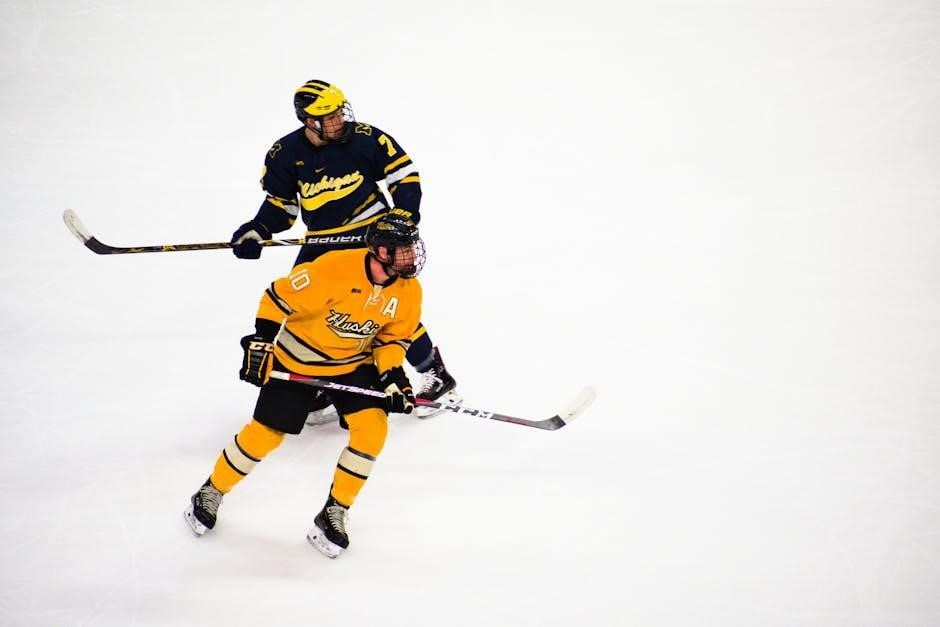
Consider trying gloves on with your goalie stick for a realistic fit. For youth goalies, opt for slightly larger sizes to accommodate growth. Always read reviews for specific fit feedback.
Trying Gloves Before Purchasing
Trying goalie gloves before purchasing is highly recommended to ensure the best fit and performance. Visit a sporting goods store to test different models, focusing on comfort and dexterity. Pay attention to how the glove feels when holding your stick, moving your wrist, and closing the fingers. If in-person trials aren’t possible, consider brands with flexible return policies to test gloves at home. When trying them on, wear the same type of hand protection you’d use during games to gauge the fit accurately. Check if the break angle aligns with your hand shape and whether the cuff allows sufficient mobility. Properly fitted gloves should feel snug but not restrictive, allowing precise control and movement. This step is crucial for optimizing performance and avoiding sizing regrets;
Using Online Size Guides Effectively
Online size guides are invaluable tools for selecting the right goalie gloves, especially when in-person trials aren’t possible. Start by carefully reviewing the size chart provided by the manufacturer, as sizing can vary between brands. Measure your hand accurately, focusing on palm circumference and hand length, to align with the chart’s specifications. Pay attention to any notes about snug vs. loose fits, as this can influence your choice. Many websites offer detailed sizing tips or video guides to help you measure correctly. If unsure, compare your measurements to multiple brands’ charts to find consistency. Additionally, read customer reviews to gauge how others with similar hand sizes fare with the gloves. Using online size guides effectively ensures a better fit and reduces the likelihood of needing exchanges. Always double-check measurements before finalizing your purchase for optimal comfort and performance.
Pros and Cons of Tight vs. Loose Gloves
When choosing goalie gloves, deciding between a tight or loose fit is crucial. Tight gloves offer better control and precision, as they allow goalies to grip the stick firmly and make quick movements. However, overly tight gloves can restrict finger movement and cause discomfort during long games. On the other hand, loose gloves provide comfort and flexibility, reducing the risk of hand fatigue. However, they may lack the precision needed for intricate saves and can shift during play, potentially affecting performance. The ideal fit strikes a balance, offering enough support without sacrificing mobility. Goalies should consider their playing style and personal comfort preferences when deciding between tight and loose gloves. Proper fit ensures peak performance and minimizes distractions during critical moments in the game. Balancing these factors is key to selecting gloves that enhance both comfort and functionality.
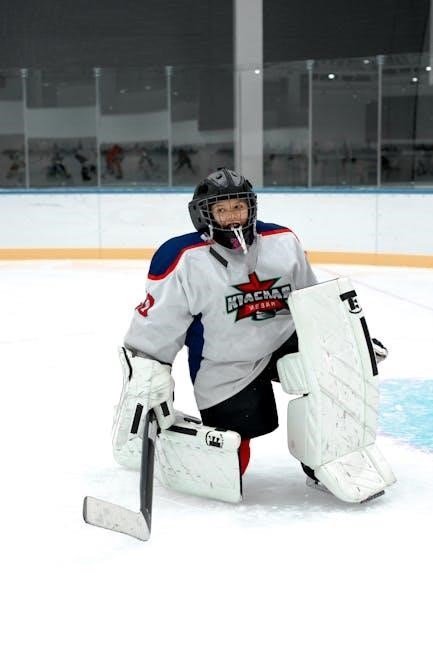
Properly fitting goalie gloves are essential for performance and comfort. Correct sizing enhances control, mobility, and confidence. Prioritize fit to optimize your game and ensure long-lasting durability.
Final Thoughts on Goalie Glove Sizing
Choosing the right goalie glove size is crucial for optimal performance and comfort. Proper fit ensures better control, mobility, and protection. A well-fitting glove enhances your ability to handle the puck and make precise saves.
Incorrect sizing can lead to reduced dexterity or discomfort, affecting your overall game. Always measure carefully and consider factors like palm circumference and hand length. Trying gloves on is ideal, but reliable size charts can guide you when shopping online.
Remember, goalie gloves are an investment in your performance and safety. Take the time to find the perfect fit, and you’ll see improvements in both confidence and results on the ice. The right gloves can make all the difference in your success as a goalie.
Importance of the Right Fit for Success
The right fit in goalie gloves is essential for peak performance and confidence. A glove that fits perfectly allows for optimal puck control, precise movements, and maximum protection. Ill-fitting gloves can hinder dexterity, reducing a goalie’s ability to make quick saves or handle the puck effectively.
A proper fit also minimizes the risk of injury by providing adequate support and cushioning against high-speed impacts. Goalies rely heavily on their hands to react swiftly, and any restriction or discomfort can compromise their game.
Investing time in finding the right size ensures that every movement is precise and every save is confident. The right fit empowers goalies to perform at their best, making it a cornerstone of their success on the ice.